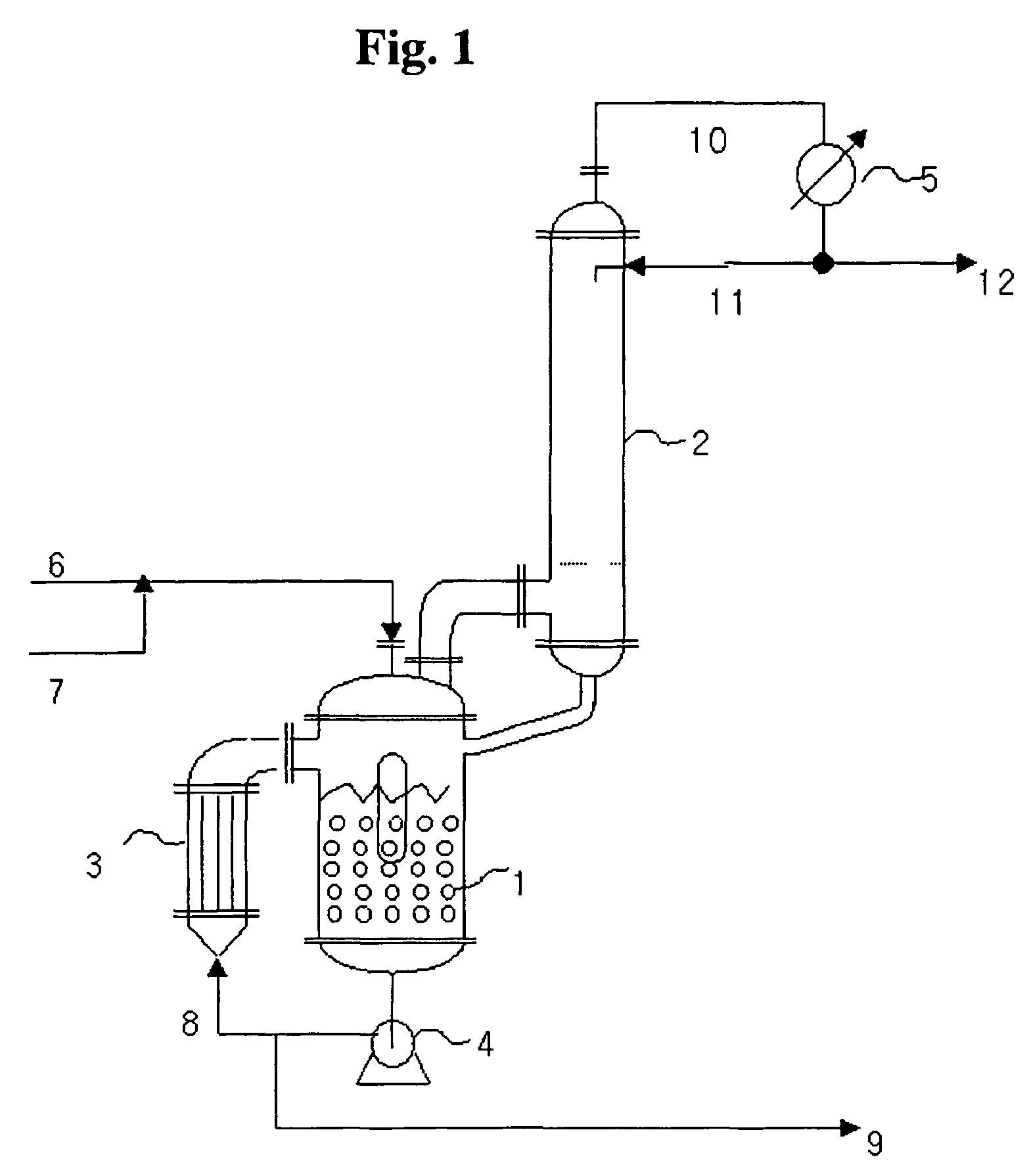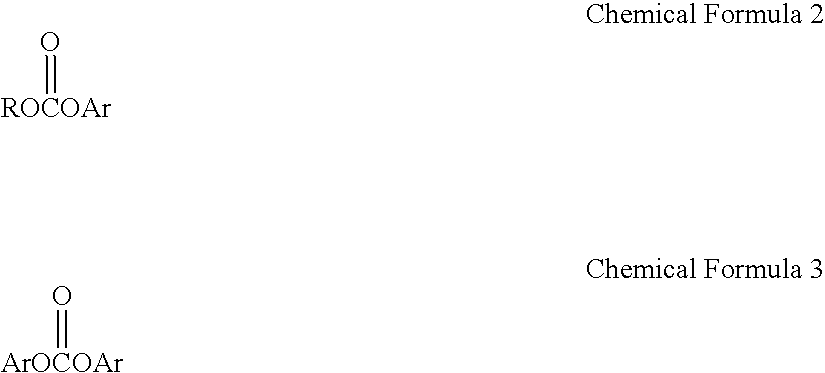Continuous method for preparing aromatic carbonate using a heterogeneous catalyst and a reaction apparatus for the same
a heterogeneous catalyst and reaction apparatus technology, applied in the direction of organic chemistry, carbonic/haloformic acid esters purification/separation, organic chemistry methods, etc., can solve the problems of being adhered to the inside walls of pipes and equipment, the conversion rate after reaction is very low, and the reaction rate is quite slow. , to achieve the effect of low cos
- Summary
- Abstract
- Description
- Claims
- Application Information
AI Technical Summary
Benefits of technology
Problems solved by technology
Method used
Image
Examples
example 1
[0057]Dimethyl carbonate (DMC) was used as a source of dialkyl carbonate, and as an aromatic hydroxy compound, phenol was used. Dimethyl carbonate (DMC) and phenol, which are starting materials, were pre-mixed at a molar ratio of 3:1 and then they were continuously injected into the reactor using a quantitative high pump at a flow rate of 33.3 g / minute.
[0058]The reaction temperature was 160° C., the reaction pressure was maintained at 4 atmospheres, and the flow rate of the reaction solution circulated by the circulation pump was maintained at 6.0 L / minute. The reaction was continuously carried out under the same conditions for 12 hours or longer. The catalyst used was a heterogeneous catalyst of titania (TiO2) supported on silica having a diameter of 3 mm, and the amount of the catalyst contained in the reactor was 1200 g.
[0059]As a result of the reaction, the yield of methyl phenyl carbonate (MPC) was 21.7 wt. %, and the yield of dimethyl carbonate (DPC) was 0.34 wt. %. The produc...
examples [UNK]
Examples 2˜7
[0060]The same continuous reaction as used in Example 1 above was carried out, except that the reaction conditions were changed as shown in Table 1 below. The reaction results are also shown in Table 1.
[0061]
TABLE 1CategoryEx. 2Ex. 3Ex. 4Ex. 5Ex. 6Ex. 7ReactionTemperature (° C.)160170160170160180ConditionPressure (kg)454.55.54.54.5Molar Ratio335555Feed Rate (g / min)11.511.511.511.522.433.3ReactionMolar Conversion18.4620.5924.9526.6418.8211.79ResultRate of Phenol (%)Yield of MPC (wt. %)21.0832.2939.3041.9829.6518.55Yield of DPC (wt. %)0.540.690.720.750.540.36Total Feed Amount69069069069013441998(g / h)Feed Amount of178.2178.2119.3119.3232.3345.3Phenol (g / h)Yield of MPC (g / h)53.259.348.151.370.665.8Productivity of44.349.440.142.858.954.8Catalyst(MPC g / catalyst kg · h)
example 8
[0062]In order to synthesize diphenyl carbonate (DPC) using the reaction system shown in FIG. 1, a considerable amount of dimethyl carbonate (DMC) was eliminated from the reaction products prepared from Examples 1 to 7 above using a distillation apparatus, and 50 liters of reactants were obtained with a certain compositional ratio. The compositional ratio of the reactants was an insignificant amount of methanol, 34.44 wt. % of dimethyl carbonate (DMC), 13.92 wt. % of methylphenyl carbonate, 51.64 wt. % of phenol, and 0.01 wt. % of diphenyl carbonate (DPC).
[0063]The catalyst used in the synthesis of the diphenyl carbonate was a heterogeneous catalyst where titania (TiO2) was supported on silica having a diameter of 3 mm, and the amount of the catalyst contained in mounted on the reactor was 1200 g. The reactants having the above-mentioned compositional ratio were continuously injected into the reactor, which is designed in the invention, at a constant flow rate of 1592 g / hr using a q...
PUM
| Property | Measurement | Unit |
|---|---|---|
| size | aaaaa | aaaaa |
| specific surface area | aaaaa | aaaaa |
| specific surface area | aaaaa | aaaaa |
Abstract
Description
Claims
Application Information
 Login to View More
Login to View More - R&D
- Intellectual Property
- Life Sciences
- Materials
- Tech Scout
- Unparalleled Data Quality
- Higher Quality Content
- 60% Fewer Hallucinations
Browse by: Latest US Patents, China's latest patents, Technical Efficacy Thesaurus, Application Domain, Technology Topic, Popular Technical Reports.
© 2025 PatSnap. All rights reserved.Legal|Privacy policy|Modern Slavery Act Transparency Statement|Sitemap|About US| Contact US: help@patsnap.com



